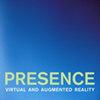Virtual Life Network: A Body-Centered Networked Virtual Environment
IF 0.7
4区 计算机科学
Q4 COMPUTER SCIENCE, CYBERNETICS
引用次数: 17
Abstract
In order to feel the sense of presence in a virtual environment, it is important for the participants to become a part of this environment and interact with it through natural behaviors. This interaction is even more important in networked collaborative virtual environments, in which the participants need to see and interact with each other. We present the Virtual Life Network (VLNET), a joint research effort in the field of networked collaborative virtual environments at MIRALab of the University of Geneva and the Computer Graphics Laboratory of the Swiss Federal Institute of Technology, Lausanne. In VLNET each participant is represented by a virtual human actor with realistic appearance and movements similar to the actual body. Interacting with the environment through his virtual body, the participant is perceived by himself and others in a natural way. Since it is generally not possible to track all degrees of freedom of the human body in order to reproduce realistic body motion, we introduce the motor functions that generate natural motion for standard tasks such as walking and arm motion; they are based on limited tracked information (hand and head positions). By using the same virtual human representation, but with the addition of high-level control, autonomous virtual actors can be introduced into the environment to perform some useful tasks or simply to make the environment more appealing. To further enhance the realistic feel of the virtual environment and to simplify object manipulation we provide the facility of defining object behaviors by attaching motor functions to the objects.虚拟生活网络:以身体为中心的网络化虚拟环境
为了在虚拟环境中感受到存在感,重要的是参与者要成为这个环境的一部分,并通过自然行为与之互动。这种互动在网络协作虚拟环境中更为重要,因为参与者需要看到彼此并相互交流。我们提出虚拟生活网络(VLNET),这是日内瓦大学MIRALab和瑞士洛桑联邦理工学院计算机图形学实验室在网络协作虚拟环境领域的一项联合研究成果。在VLNET中,每个参与者都由一个具有逼真外观和动作与实际身体相似的虚拟人类演员来代表。参与者通过他的虚拟身体与环境互动,以一种自然的方式被自己和他人感知。由于通常不可能跟踪人体的所有自由度以再现真实的身体运动,因此我们引入了为标准任务(如行走和手臂运动)产生自然运动的运动功能;它们基于有限的跟踪信息(手和头的位置)。通过使用相同的虚拟人类表示,但添加高级控制,可以将自主虚拟角色引入环境中,以执行一些有用的任务,或者只是为了使环境更具吸引力。为了进一步增强虚拟环境的真实感和简化对象操作,我们提供了通过在对象上附加运动函数来定义对象行为的功能。
本文章由计算机程序翻译,如有差异,请以英文原文为准。
求助全文
约1分钟内获得全文
求助全文
来源期刊
CiteScore
2.20
自引率
0.00%
发文量
8
审稿时长
>12 weeks

 求助内容:
求助内容: 应助结果提醒方式:
应助结果提醒方式:


